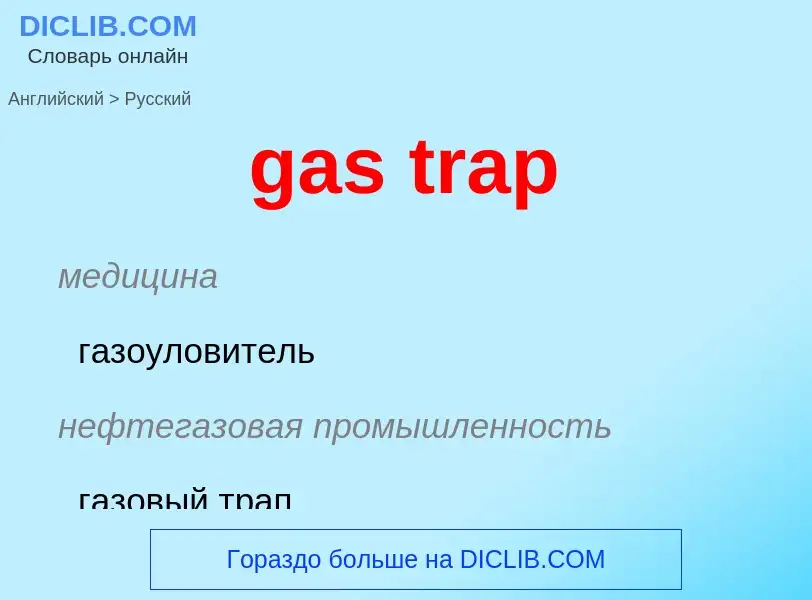Перевод и анализ слов искусственным интеллектом ChatGPT
На этой странице Вы можете получить подробный анализ слова или словосочетания, произведенный с помощью лучшей на сегодняшний день технологии искусственного интеллекта:
- как употребляется слово
- частота употребления
- используется оно чаще в устной или письменной речи
- варианты перевода слова
- примеры употребления (несколько фраз с переводом)
- этимология
gas trap - перевод на русский
медицина
газоуловитель
нефтегазовая промышленность
газовый трап
газоуловитель, газосепаратор
газоотделитель
газосепаратор
газовая ловушка
нефтегазовая промышленность
ловушка для углеводородов
общая лексика
залежь тектонически экранированая
нефтегазовая промышленность
структурная ловушка (залежь нефти, приуроченная к тектоническим структурам)
энергетика
залежь литологически экранированная
нефтегазовая промышленность
стратиграфическая ловушка (нефти, газа)
нефтегазовая промышленность
сорбция газа, поглощение газа
['træplain]
охота
система капканов
линия капканов
существительное
охота
система капканов
Определение
Википедия

Insect traps are used to monitor or directly reduce populations of insects or other arthropods, by trapping individuals and killing them. They typically use food, visual lures, chemical attractants and pheromones as bait and are installed so that they do not injure other animals or humans or result in residues in foods or feeds. Visual lures use light, bright colors and shapes to attract pests. Chemical attractants or pheromones may attract only a specific sex. Insect traps are sometimes used in pest management programs instead of pesticides but are more often used to look at seasonal and distributional patterns of pest occurrence. This information may then be used in other pest management approaches.
The trap mechanism or bait can vary widely. Flies and wasps are attracted by proteins. Mosquitoes and many other insects are attracted by bright colors, carbon dioxide, lactic acid, floral or fruity fragrances, warmth, moisture and pheromones. Synthetic attractants like methyl eugenol are very effective with tephritid flies.


![nocturnal]] species. nocturnal]] species.](https://commons.wikimedia.org/wiki/Special:FilePath/An insect trap mounted onto a pick-up truck - ZooKeys-235-041-g003.jpeg?width=200)


![tilted blocks]] tilted blocks]]](https://commons.wikimedia.org/wiki/Special:FilePath/StratigraphicTrap5.png?width=200)
![[[Long-billed hermit]] (''Phaethornis longirostris baroni''), a species of traplining hummingbird adapted for flying long distances [[Long-billed hermit]] (''Phaethornis longirostris baroni''), a species of traplining hummingbird adapted for flying long distances](https://commons.wikimedia.org/wiki/Special:FilePath/Phaethornis longirostris baroni.jpg?width=200)
![[[Rufous hummingbird]] (''Selasphorus rufus''), a species of territorial hummingbird, is more robust than traplining species [[Rufous hummingbird]] (''Selasphorus rufus''), a species of territorial hummingbird, is more robust than traplining species](https://commons.wikimedia.org/wiki/Special:FilePath/Selasphorus rufus1.jpg?width=200)


![blue]] [[flame]] colour, meaning complete combustion, as with other gas appliances. blue]] [[flame]] colour, meaning complete combustion, as with other gas appliances.](https://commons.wikimedia.org/wiki/Special:FilePath/Gas oven flame.jpg?width=200)
![Early gas stoves produced by Windsor. From ''[[Mrs Beeton's Book of Household Management]]'', 1904. Early gas stoves produced by Windsor. From ''[[Mrs Beeton's Book of Household Management]]'', 1904.](https://commons.wikimedia.org/wiki/Special:FilePath/Gas stove 1851.jpg?width=200)
.jpg?width=200)
